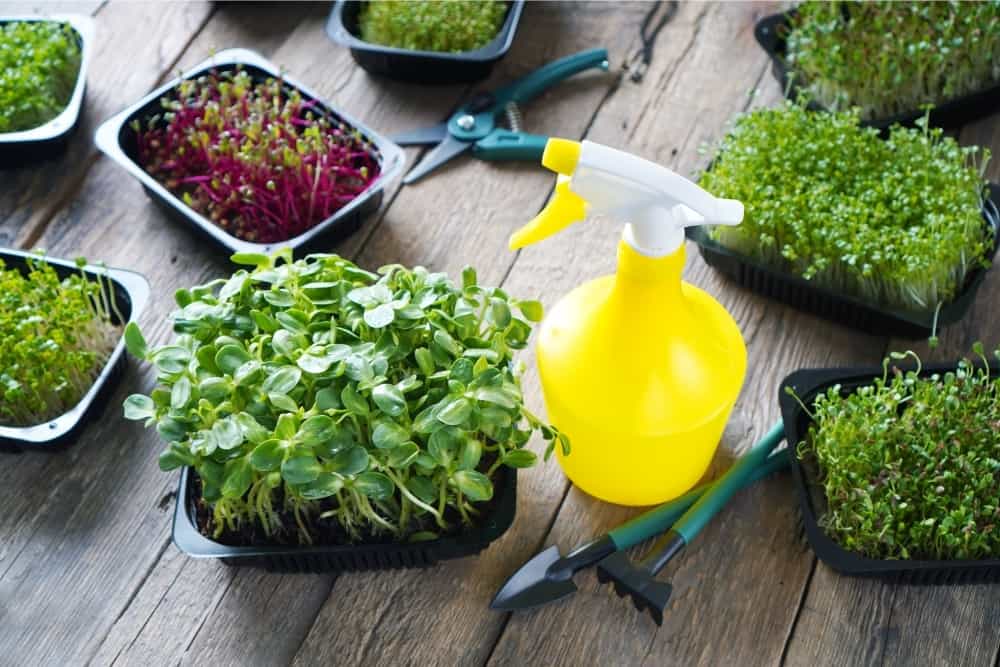If you’re thinking about giving microgreens a try, then read on and find out what plants can be grown as microgreens as your best options.
Microgreens can fight cancer, lower risks of heart diseases, lower cholesterol, and ply you with fiber that can aid digestion. These are just some of the benefits that microgreens can give you.
Microgreens are mini versions of your favorite vegetables or herbs that are packed with many flavors and nutrients. As a bonus, you can grow them indoors and typically harvest them within two weeks of planting.
If you’re thinking about giving microgreens a try, then read on and find out which plants and herbs are your best options.
What Is a Microgreen Anyway?
Microgreens are seedlings that you can eat. It’s gaining popularity now because these plants are rich in nutrients and can give you a more diverse texture and intense flavors when you eat it.
As this article points out, microgreens are functional food, which means that they can easily provide your body with nutrients. You can grow these on window ledges, your kitchen, and other areas because of its smaller size.
Adding microgreens can give food more texture, color, and flavor, particularly in sandwiches and salads. You can also use them as a garnish.
The Differences Between Sprouts and Microgreens
While both are young seedlings, there is a notable difference between sprouts and microgreens. According to Urban Cultivator, sprouts and microgreens have different tastes and looks. To make it easier to understand, sprouts come from seeds, and microgreens are at that stage of growth after the sprouting stage.
As such, sprouts are just the crunchy stems of the baby plants. Once they develop real leaves, that’s when you can call them microgreens. The first leaves of microgreens are typically the cotyledon, which are the leaves formed in the seeds and are useful in making food for the germinating seeds and, subsequently, young plants.
Sprouts take days to come out, and microgreens can take anywhere from one to three weeks. What’s more, sprouts are often started in water, while you plant seeds in the soil for microgreens. Microgreens also have more flavor and nutrients than sprouts and even full-grown vegetables.
To make it easier, the differences between microgreens and sprouts are:
- Microgreens germinate in soil, whereas sprouts germinate in water.
- The seeds and stem of sprouts are edible, while you can only eat the leaves and stems of microgreens. You cannot eat the seeds of microgreens because they’re within the soil, while sprouts typically do not have leaves yet.
- Sprouts are visible after one week of putting the seeds in water. You need anywhere from one to three weeks to grow microgreens.
- Sprouts have very minimal nutrients and are often used only for their crunch, while microgreens can provide you with more nutrients than adult plants.
So, What Plants Can Be Grown as Microgreens?
Most vegetables and herbs can be grown as microgreens. However, it’s best to list them according to the family that they belong to. According to this page, the different types of microgreens you can grow, including some examples, are:
- Amaranthaceae
- Spinach
- Quinoa
- Chard
- Beets
- Amaranth
- Amaryllidaceae
- Onions
- Leeks
- Garlic
- Chives
- Apiaceae
- Fennel
- Dill
- Celery
- Carrot
- Asteraceae
- Radicchio
- Lettuce
- Endive
- Chicory
- Brassicaceae
- Watercress
- Radish
- Cauliflower
- Cabbage
- Broccoli
- Arugula
- Cucurbitaceae
- Squashes
- Melons
- Cucumbers
- Common herbs, including
- Sage
- Rosemary
- Oregano
- Mint
- Basil
- Grasses and cereals, including
- Wheatgrass
- Rice
- Oats
- Corn
- Barley
- Legumes, including
- Lentils
- Chickpeas
- Beans
The Microgreens That Are Easiest to Grow
For the most part, however, you might want to know which ones are the easiest to grow. Beginners in the microgreens game will find it rewarding to see seeds turn to microgreens so fast and with minimal effort.

The five microgreens that top that list are:
- Arugula. Arugula only takes around ten days to be ready for harvest. It’s an ingredient that is popular among home cooks and chefs because of its nutty and zesty flavor.
- Basil. Basil seeds don’t need to be soaked in water before you plant it, and it germinates in around five to seven days and ready to harvest within 12 to 16 days. It has a mild herbaceous flavor.
- Broccoli. Broccoli takes about two to three days to germinate, and you can harvest it in eight to 12 days. This one has a mild and slightly bitter flavor and crunchy texture. Broccoli microgreens are an excellent source of sulforaphane, which has both anti-bacterial and anti-cancer properties.
- Cabbage. Cabbage is similarly fast to grow, germinating in three days and ready for harvest in as little as six to 14 days.
- Radish. Some people find radish the easiest to grow because of its larger and lighter colored seeds, making it a breeze to spread in your soil bed. Plus, you can harvest it in 10 days. Radish microgreens have a delicately peppery and spicy flavor.
Microgreens, According to Seed Size
Beginners to growing microgreens might want to try those with larger seeds first, because they are generally easier to grow, according to this page. You can easily space them.
Large microgreen seeds are easiest to handle and grow, but compared to other microgreens, the plant density might be lower because they also tend to have stouter stems. With large seeds, you may need to presoak them before putting them into the soil.
Some of the microgreens with big seeds that you can grow:
- Wheatgrass
- Lentils
- Mung beans
- Pea
- Sunflower
- Kohlrabi
- Buckwheat
- Chickpea
- Barley
- Cilantro
- Kale
Medium microgreen seeds may be easier to grow if you presoak them, but you can get away with putting them straight onto the soil bed most of the time.
- Arugula
- Lettuce
- Leek
- Chia
- Cauliflower
- Basil
- Spinach
- Radish
- Mustard
- Mustard
- Fenugreek
- Turnip
Small microgreen seeds are a bit more of a challenge because you will have difficulty sowing them evenly. But if you’re going for a thick mat of plants, then these are your best bets. Most herbs have small microgreen seeds, and you will notice that these tiny seeds can pack an intense flavor when they sprout out of the soil.
- Oregano
- Mint
- Celery
- Amaranth
- Thyme
- Tarragon
- Sage
- Marjoram
Which Microgreens Are the Most Nutritious?
When it comes to nutrients, microgreens are king. A US Department of Agriculture study shows that the 25 microgreens they studied had more phytonutrients than their mature counterparts.
In general, microgreens had varying levels of vitamins, minerals, and carotenoids. Out of more than two dozen microgreens, it was shown that:
- Red cabbage had the highest levels of vitamin C
- Cilantro possessed the highest concentration of carotenoids with its strong celery and citrus flavor.
- Garnet amaranth with its earthy flavor that’s similar to beet topped the phylloquinone game.
- Green daikon radish had the most tocopherols.

Carotenoids are antioxidants that can help you make your immune system stronger and fight off certain diseases. It’s also essential for healthy eyes and heart. It can also get rid of free radicals that may cause cancer.
Vitamin C has been shown to help you have a more robust immune system, prevent infection, and helps your body absorb more iron. And while it may not help you prevent a cold, it does help lessen the severity of the symptoms.
Phylloquinone, on the other hand, is vitamin K1 and it comes from plants. According to this article, vitamin K1 is necessary for blood to clot and in bone metabolism. Lastly, tocopherols are compounds that make up vitamin E. These are potent antioxidants. It has also been shown to help prevent clogged arteries, Alzheimer’s disease, and cancer.
Vitamin E also has supposed anti-aging and anti-inflammation benefits. It can also lower the risk of developing eye problems and cancer.
Are Other Nutrients Present in Microgreens?
According to this study, microgreens are rich in these minerals:
- Potassium
- Phosphorus
- Calcium
- Magnesium
- Sulfur
- Sodium
- Iron
- Zinc
- Manganese
- Copper
- Nickel
- Cadmium
What Other Microgreens Should You Grow for Their Nutrients?
Aside from red cabbage, cilantro, garnet amaranth, and green daikon radish, what are other microgreens that you should grow?
Pea shoots are excellent sources of vitamins A, C, and E, and potassium and dietary fiber. Plus, these nutrients are stable and won’t be lost during storage. Other types of radishes might be a good idea. They are very easy to grow and are spicy microgreens packed with vitamins and minerals, including calcium, iron, phosphorus, potassium, vitamins A, and C.
According to this page, sunflower microgreens are excellent sources of healthy fats and calories, making it more filling when added to salads. You can also get iron, fiber, and calcium requirements from them. What’s more, it also contains vitamins A, B, C, D, and E and minerals such as magnesium, phosphorus, and potassium. They’re much easily digested than the seeds too.
When it comes to nutrition, wheatgrass is rich in vitamins A, C, E, and B complex. It also gives you selenium, a powerful antioxidant that can prevent heart disease, mental decline, and certain cancers. Wheatgrass can also supply you with 17 different amino acids and help reduce cholesterol, regulate blood sugar, and fight inflammation.
Eat Microgreens to Meet Your Recommended Daily Allowance
There are vitamins and minerals that our body needs that we are not getting enough of. The good news is that you may get these nutrients and micronutrients from microgreens. And because you can eat microgreens raw, there is no heat from cooking that can diminish their nutrition.
For instance, the World Health Organization says that close to one in every four people worldwide suffer from anemia, which is most likely caused by iron deficiency.
Microgreens such as spinach, kale, collard, beet greens, lentils, peas, and beans have higher concentrations of iron that you can eat to help get the recommended daily intake for the nutrient.
So if you’re choosing which microgreens to grow, you might want to assess first what kinds of nutrients you and your family need the most and then select microgreens that will provide these nutrients.
Which Microgreens Grow Back After you Harvest Them?
The most challenging part of growing microgreens are probably spreading them evenly into the soil to make are not too close together, but still dense enough for a bountiful harvest. You also have a few days’ worth of waiting for them to emerge from the soil and then be ready for harvest.
You can probably skip the seeding part and wait a few days less if you choose microgreens that can regrow after being cut and harvested. What are your choices? It seems that there are very few microgreens that fit the bill.
According to this site, most microgreens won’t be able to regrow after you harvest or cut them. On top of being packed too densely in the soil, which quickly depletes the nutrients, young plants are more vulnerable to fungus.
As such, most microgreens have a tough time regrowing after you have cut it. What’s more, the regrown microgreens will be smaller the first round of growth, so while it’s not impossible, you’d be better off with just throwing everything into your compost and starting anew.
However, if you think it’s wasteful to do so, you can choose microgreens that may be regrown.
Lettuce can continue growing. If you have microgreens, you can just cut the leaves that you need and let the others continue growing. Leaving just enough stem, the leaves can regrow. You can get more harvests from other salad greens this way.
Green peas, snow peas, snap peas, fava beans, and speckled peas can grow back after harvesting. Kale can also regrow after being cut.
You harvest wheatgrass when they are more than seven inches tall. Cutting as close to the soil as possible, your wheatgrass can grow back for a second or third harvest.
Other Microgreens You Should Know About
Aside from arugula, broccoli, lettuce, peas, and other microgreens we have already mentioned, here are some more microgreens you can grow.
Carrots
Carrot microgreens can be very slow to grow and may take anywhere from five or more weeks before it is ready to be harvested from the time you plant it on the ground. But if you love the taste of its orange seed, then you will love the microgreens version.
Celery
Celery microgreens can be used if you like that herb flavor in your salad or as a garnish. The taste can be a bit strong.
Chives
Microgreen chives can be used as a replacement for mature leaves. They can be used as a decorative garnish as well. These microgreens are slower to germinate than others.
Kale
As microgreens, kale has tender and delicious leaves that is bluish-green. Kale in itself is considered a superfood, but its microgreen version has around three to four times the nutrients that adult kale has.
Kale takes up to three days to germinate and can be harvested in eight to 12 days.
Mustard
Mustard has a peppery flavor and is very easy to grow. But more than its use in salads and sandwiches, it’s an excellent source of vitamins A, C, E, and K, as well as protein, calcium, iron, fiber, and folate.
Shungiku
Shungiku or edible chrysanthemums are used in cooking Chinese and oriental dishes. It has an exciting flavor that can be described as pleasant and fresh.
Rich in Vitamins C, B, and K, as well as fiber and folic acid, can be harvested in around 10 to 20 days.
Beet
Beet is an excellent microgreen if you want to add intense color to your food. Beet seeds need to be soaked and they germinate in around six to eight days. Beet microgreens can be harvested 10 to 12 days when it develops green leaves with its dark red or purple stems.
Cucumber
Cucumber microgreens are easy to grow and maintain. It has a mild cucumber taste that you can enjoy with your salad or soup. It takes only two days to germinate and is ready for harvesting in seven to 12 days.
Chia
Chia seeds are known for their many health benefits, but if you’re looking for more ways to incorporate chia into your diet, you can grow them as microgreens.
Even when they sprout leaves and grow, chia remains very beneficial to our health. It’s an excellent source of calcium that makes your bones and teeth strong and your heart healthy. It also has omega-3 fatty acids that can keep your brain healthy.
It’s also vitamin-rich and has high levels of iron and potassium. Chia germinates in one to two days and can be harvested in 10 to 12 days.
Growing Microgreens for a Healthier Life
With a potting tray, potting soil mix, seeds, and light, you can grow microgreens versions of your favorite greens, herbs, and crops. If you like carrots, for example, you can get that similar taste in its microgreen version. They are not only very nutritious and healthy; they can be delicious additions to sandwiches, salads, and dishes.
Microgreens are generally easier to grow and you can even grow it in your kitchen, shed, or window sill provided that the area has the right amount of light. The biggest thing is that you don’t have to wait for months to enjoy their delicious flavor and nutrients.

